what large, overall igneous feature makes up the sierra nevada mountains in california?
4.1: Nomenclature of Igneous Rocks
- Page ID
- 6860
Igneous rocks are classified based on texture and composition. Texture describes the concrete characteristics of the minerals, such as grain size. This relates to the cooling history of the molten magma from which information technology came. Composition refers to the rock's specific mineralogy and chemical limerick. Cooling history is besides related to changes that can occur to the limerick of igneous rocks.
Texture
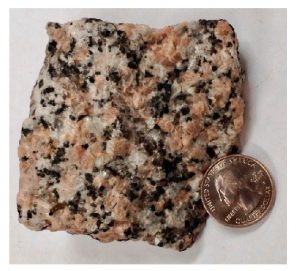
If magma cools slowly, deep within the chaff, the resulting rock is chosen intrusive or plutonic. The slow cooling process allows crystals to grow large, giving the intrusive igneous rock a coarse-grained or phaneritic texture. The individual crystals in phaneritic texture are readily visible to the unaided eye.
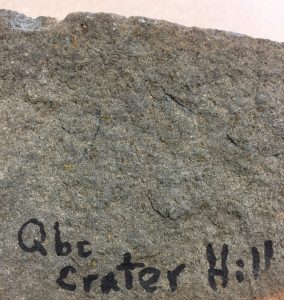
When lava is extruded onto the surface, or intruded into shallow fissures nigh the surface and cools, the resulting igneous stone is called extrusive or volcanic. Extrusive igneous rocks have a fine-grained or aphanitic texture, in which the grains are too small-scale to run into with the unaided eye. The fine-grained texture indicates the apace cooling lava did not have time to grow big crystals. These tiny crystals tin can be viewed nether a petrographic microscope [i]. In some cases, extrusive lava cools and so apace it does non develop crystals at all. This non-crystalline cloth is not classified equally minerals but as volcanic glass. This is a common component of volcanic ash and rocks similar obsidian.
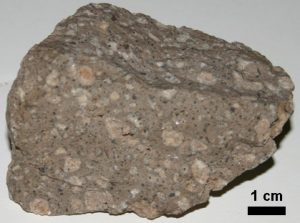
Some igneous rocks take a mix of fibroid-grained minerals surrounded by a matrix of fine-grained fabric in a texture called porphyritic. The large crystals are called phenocrysts and the fine-grained matrix is called the groundmass or matrix. Porphyritic texture indicates the magma body underwent a multi-phase cooling history, cooling slowly while deep under the surface and later rising to a shallower depth or the surface where information technology cooled more quickly.
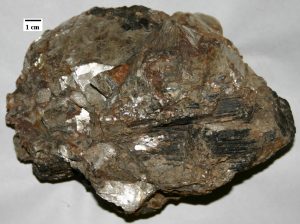
Residual molten textile expelled from igneous intrusions may form veins or masses containing very large crystals of minerals like feldspar, quartz, beryl, tourmaline, and mica. This texture, which indicates a very slow crystallization, is called pegmatitic. A rock that chiefly consists of pegmatitic texture is known as a pegmatite. To requite an example of how large these crystals can get, transparent cleavage sheets of pegmatitic muscovite mica were used equally windows during the Centre Ages.
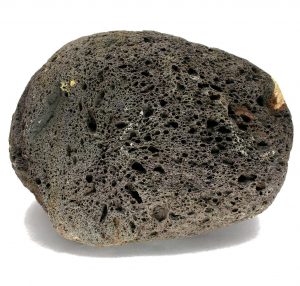
All magmas contain gases dissolved in a solution called volatiles. Equally the magma rises to the surface, the drop in pressure causes the dissolved volatiles to come bubbling out of solution, like the fizz in an opened bottle of soda. The gas bubbles become trapped in the solidifying lava to create a vesicular texture, with the holes specifically called vesicles. The type of volcanic rock with mutual vesicles is chosen scoria.
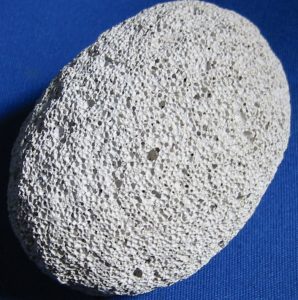
An extreme version of scoria occurs when volatile-rich lava is very rapidly quenched and becomes a meringue-like froth of glass chosen pumice . Some pumice is so full of vesicles that the density of the stone drops low enough that it will float.

Lava that cools extremely speedily may non form crystals at all, even microscopic ones. The resulting rock is called volcanic drinking glass. O bsidian is a rock consisting of volcanic glass. Obsidian as a burnished rock shows an excellent instance of conchoidal fracture similar to the mineral quartz (run into Affiliate 3).

When volcanoes erupt explosively, vast amounts of lava, stone, ash, and gases are thrown into the atmosphere. The solid parts, called tephra, settle back to world and cool into rocks with pyroclastic textures. Pyro, meaning burn down, refers to the igneous source of the tephra and clastic refers to the stone fragments. Tephra fragments are named based on size—ash (<ii mm), lapilli (2-64 mm), and bombs or blocks (>64 mm). Pyroclastic texture is usually recognized by the cluttered mix of crystals, angular glass shards, and stone fragments. Rock formed from large deposits of tephra fragments is chosen tuff. If the fragments accumulate while still hot, the heat may deform the crystals and weld the mass together, forming a welded tuff.
Composition
Limerick refers to a stone's chemical and mineral make-up. For igneous stone, the composition is divided into four groups: felsic, intermediate, mafic, and ultramafic . These groups refer to differing amounts of silica, iron, and magnesium found in the minerals that make up the rocks. It is of import to realize these groups practise non have sharp boundaries in nature, but rather lie on a continuous spectrum with many transitional compositions and names that refer to specific quantities of minerals. Every bit an case, granite is a commonly-used term but has a very specific definition which includes exact quantities of minerals like feldspar and quartz. Rocks labeled as 'granite' in laymen applications can be several other rocks, including syenite, tonalite, and monzonite. To avoid these complications, the following figure presents a simplified version of igneous stone nomenclature focusing on the four master groups, which is adequate for an introductory student.
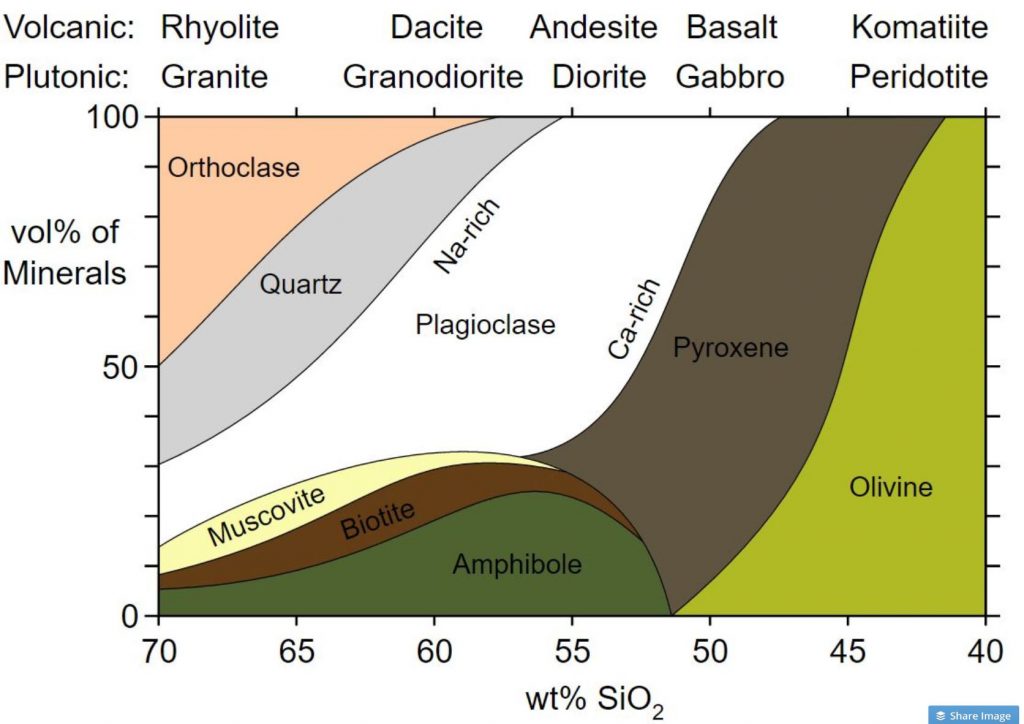
- Fel sic refers to a predominance of the light-colored (felsic) minerals fel dspar and si lica in the form of quartz. These lite-colored minerals accept more silica every bit a proportion of their overall chemical formula. Small-scale amounts of dark-colored (mafic) minerals like amphibole and biotite mica may be present equally well. Felsic igneous rocks are rich in silica (in the 65-75% range, meaning the stone would be 65-75% weight percent SiO2) and poor in fe and magnesium.
- Intermediate is a composition between felsic and mafic. It usually contains roughly-equal amounts of light and dark minerals, including light grains of plagioclase feldspar and dark minerals like amphibole. It is intermediate in silica in the 55-60% range.
- Maf ic refers to an abundance of ferromagnesian minerals (with magnesium and iron, chemical symbols M g and F e) plus plagioclase feldspar. It is more often than not made of dark minerals similar pyroxene and olivine, which are rich in iron and magnesium and relatively poor in silica. Mafic rocks are depression in silica, in the 45-50% range.
- Ultramafic refers to the extremely mafic rocks composed of more often than not olivine and some pyroxene which have even more magnesium and atomic number 26 and fifty-fifty less silica. These rocks are rare on the surface, simply make up peridotite, the rock of the upper mantle. It is poor in silica, in the 40% or less range.
On the figure above, the top row has both plutonic and volcanic igneous rocks arranged in a continuous spectrum from felsic on the left to intermediate, mafic, and ultramafic toward the right. Rhyolite refers to the volcanic and felsic igneous rocks and granite refer to intrusive and felsic igneous rocks. Andesite and diorite likewise refer to extrusive and intrusive intermediate rocks (with dacite and granodiorite applying to those rocks with limerick between felsic and intermediate).
Basalt and gabbro are the extrusive and intrusive names for mafic igneous rocks, and peridotite is ultramafic, with komatiite equally the fine-grained extrusive equivalent. Komatiite is a rare rock because volcanic material that comes direct from the drapery is not mutual, although some examples tin exist found in ancient Archean rocks [2]. Nature rarely has abrupt boundaries and the classification and naming of rocks often impose what appears to exist sharp boundary names onto a continuous spectrum.
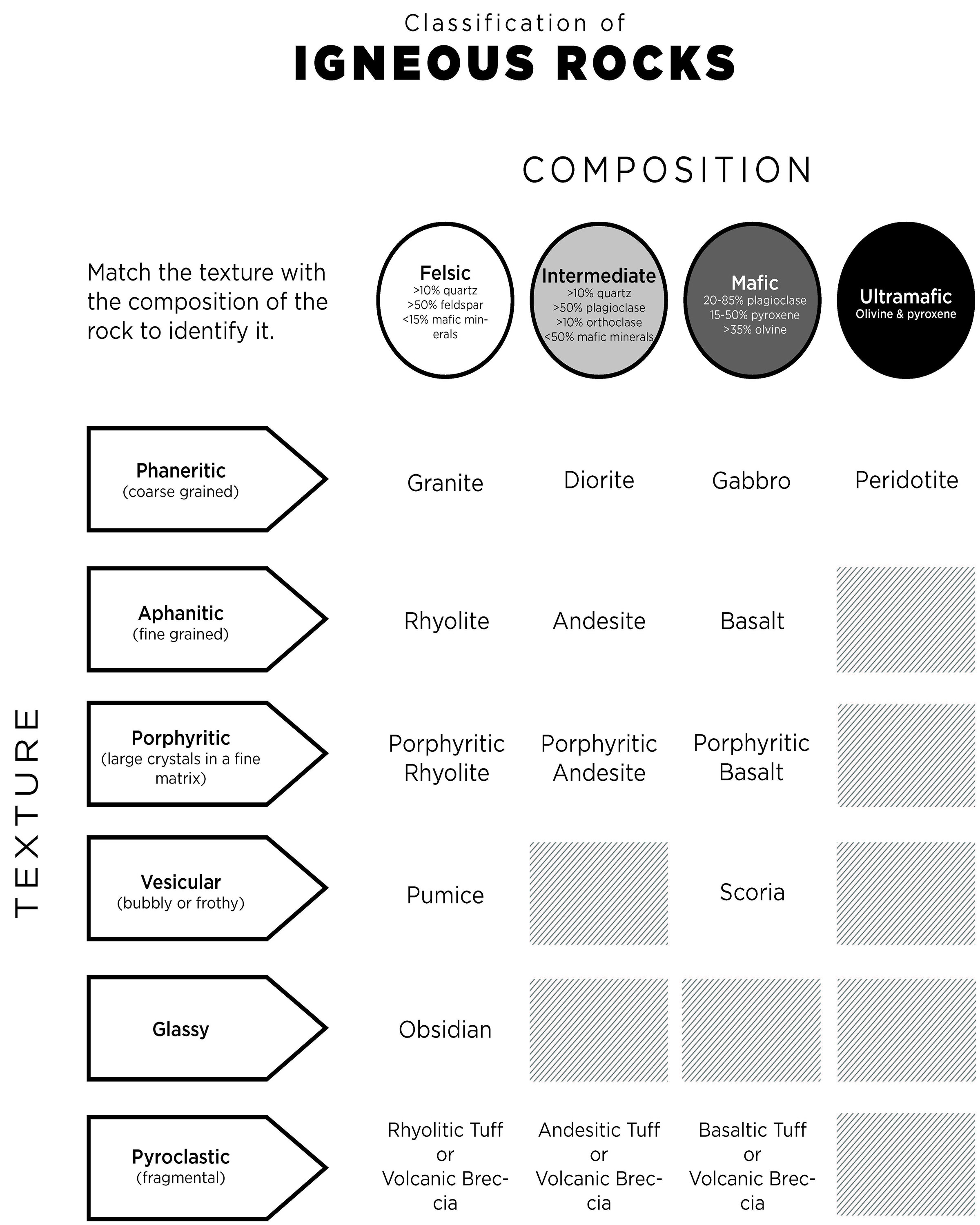
Aphanitic/Phaneritic Rock Types with Images
| Felsic Limerick | |
![Past B.West. Hallett, V. F. Paskevich, 50.J. Poppe, Due south.1000. Brand, and D.Due south. Blackwood [Public domain], <a href="https://commons.wikimedia.org/wiki/File%3AQuartz_monzonite_36mw1037.jpg">via Wikimedia Eatables</a> Photograph of cut granite. showing a variety of visible minerals, including quartz and k-feldspar.](https://geo.libretexts.org/@api/deki/files/8217/550px-Quartz_monzonite_36mw1037.jpg?revision=1) | 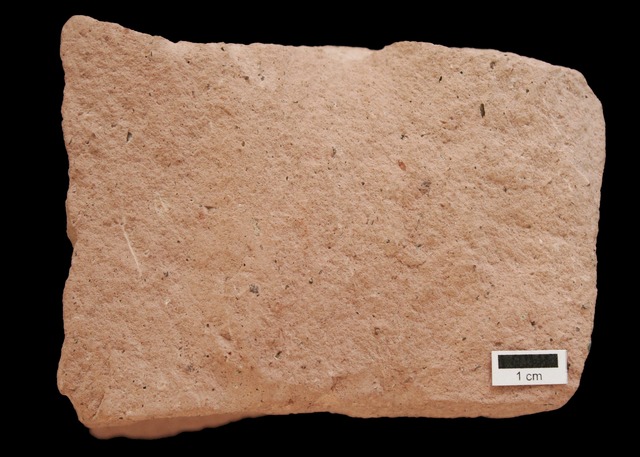 |
| Granite is a course-crystalline felsic intrusive rock. The presence of quartz is a good indicator of granite. Granite commonly has big amounts of salmon pink potassium feldspar and white plagioclase crystals that accept visible cleavage planes. Granite is a expert approximation for the continental crust, both in density and composition. | Rhyolite is a fine-crystalline felsic extrusive rock. Rhyolite is commonly pink and will oftentimes take glassy quartz phenocrysts. Because felsic lavas are less mobile, information technology is less common than granite. Examples of rhyolite include several lava flows in Yellowstone National Park and the altered rhyolite that makes upwardly the Grand Canyon of the Yellowstone. |
| Intermediate Composition | |
![By Amcyrus2012 (Own piece of work) [<a href="http://creativecommons.org/licenses/by/4.0">CC By iv.0</a>], <a href="https://commons.wikimedia.org/wiki/File%3ADiorite_MA.JPG">via Wikimedia Commons</a> Rock with visible black and white crystals.](https://geo.libretexts.org/@api/deki/files/8222/Diorite_MA-e1496027879779.jpg?revision=1) | ![Past Michael C. Rygel (Ain piece of work) [<a href="http://creativecommons.org/licenses/by-sa/3.0">CC BY-SA 3.0</a>], <a href="https://commons.wikimedia.org/wiki/File%3AAndesite2.tif">via Wikimedia Commons</a> Grey rock with fine crystals and black phenocrysts.](https://geo.libretexts.org/@api/deki/files/8224/Andesite2.tif.jpg?revision=1) |
| Diorite is a coarse-crystalline intermediate intrusive igneous stone. Diorite is identifiable by it'south Dalmatian-like appearance of blackness hornblende and biotite and white plagioclase feldspar. It is found in its namesake, the Andes Mountains every bit well as the Henry and Abajo mountains of Utah. | Andesite is a fine crystalline intermediate extrusive rock. It is normally grey and porphyritic. It can be found in the Andes Mountains and in some island arcs (meet Chapter two). It is the fine grained compositional equivalent of diorite. |
| Mafic Composition | |
 | ![By Jstuby at en.Wikipedia (Ain workTransferred from en.Wikipedia) [Public domain], <a href="https://commons.wikimedia.org/wiki/File%3AVessicularBasalt1.JPG">via Wikimedia Commons</a> Night grey rock with many visible holes and no visible crystals.](https://geo.libretexts.org/@api/deki/files/8226/VessicularBasalt1.jpg?revision=1) |
| Gabbro is a coarse-grained mafic igneous stone, made with mainly mafic minerals like pyroxene and but minor plagioclase. Because mafic lava is more mobile, information technology is less common than basalt. Gabbro is a major component of the lower oceanic crust. | Basalt is a fine-grained mafic igneous rock. It is commonly vesicular and aphanitic. When porphyritic, it often has either olivine or plagioclase phenocrysts. Basalt is the main rock which is formed at mid-ocean ridges, and is therefore the almost common rock on the Earth'due south surface, making up the entirety of the sea flooring (except where covered past sediment). |
Igneous Rock Bodies
Igneous rocks are common in the geologic record, only surprisingly, it is the intrusive rocks that are more common. Extrusive rocks, because of their pocket-sized crystals and glass, are less durable. Plus, they are, by definition, exposed to the elements of erosion immediately. Intrusive rocks, forming underground with larger, stronger crystals, are more likely to last. Therefore, most landforms and rock groups that owe their origin to igneous rocks are intrusive bodies. A pregnant exception to this is active volcanoes, which are discussed in a afterwards section on volcanism. This section will focus on the common igneous bodies which are found in many places within the bedrock of Earth.
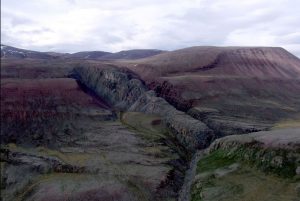
When magma intrudes into a weakness like a scissure or a fissure and solidifies, the resulting cross-cutting characteristic is called a dike (sometimes spelled dyke). Considering of this, dikes are often vertical or at an bending relative to the pre-existing rock layers that they intersect. Dikes are therefore discordant intrusions, not post-obit whatsoever layering that was present. Dikes are important to geologists, not but for the study of igneous rocks themselves but also for dating rock sequences and interpreting the geologic history of an area. The dike is younger than the rocks it cuts across and, equally discussed in the chapter on Geologic Fourth dimension (Chapter vii), may be used to assign actual numeric ages to sedimentary sequences, which are notoriously difficult to age date.
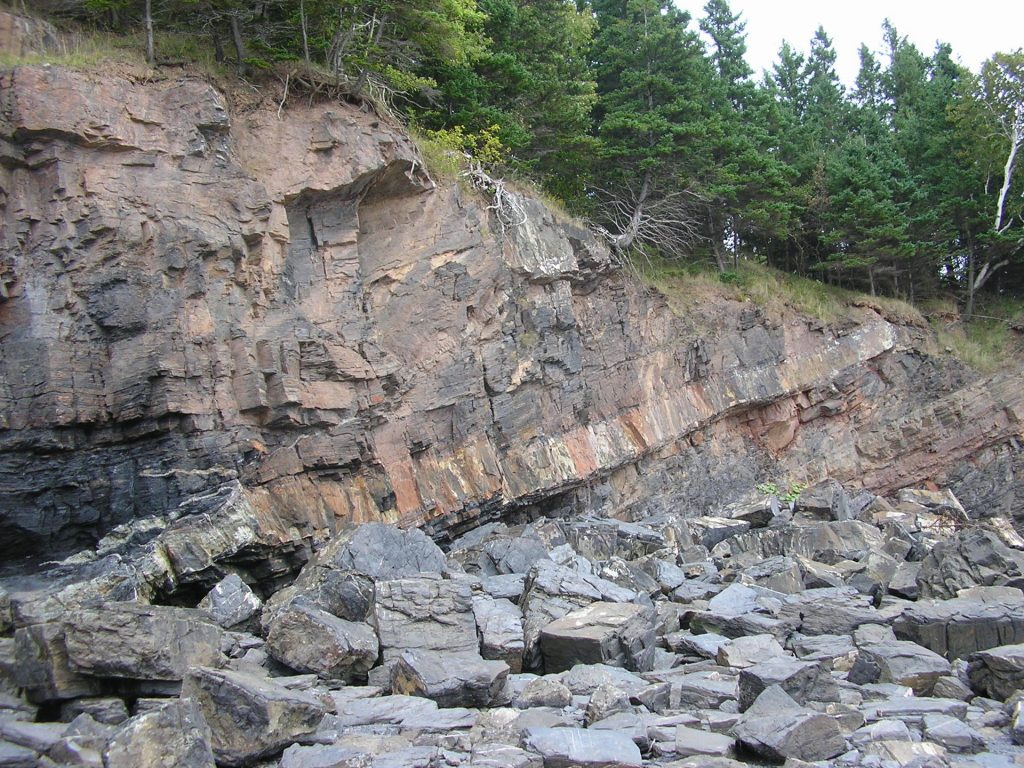
Sills are another blazon of intrusive construction. A sill is a concordant intrusion that runs parallel to the sedimentary layers in the country rock. They are formed when magma exploits a weakness between these layers, shouldering them apart and squeezing between them. As with dikes, sills are younger than the surrounding layers and may be radioactively dated to study the age of sedimentary strata.
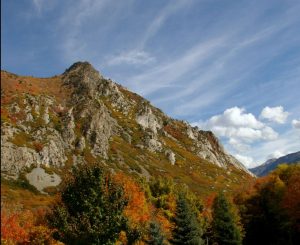
A magma bedchamber is a big underground reservoir of molten rock. The path of rising magma is called a diapir. The processes by which a diapir intrudes into the surrounding native or country stone are not well understood and are the discipline of ongoing geological inquiry [three]. For example, it is non known what happens to the pre-existing country rock equally the diapir intrudes. One theory is the overriding rock gets shouldered aside, displaced by the increased book of magma. Another is the native stone is melted and consumed into the ascent magma or broken into pieces that settle into the magma, a process known equally stoping. It has also been proposed that diapirs are not a existent miracle, but just a series of dikes that blend into each other. The dikes may be intruding over millions of years, but since they may be made of similar material, they would exist appearing to be formed at the aforementioned fourth dimension. Regardless, when a diapir cools, it forms a mass of intrusive rock chosen a pluton. Plutons tin can take irregular shapes, merely tin can often exist somewhat round.
![Past Jon Sullivan ([1]) [Public domain], <a data-cke-saved-href="https://commons.wikimedia.org/wiki/File%3AYosemite_20_bg_090404.jpg" href="https://commons.wikimedia.org/wiki/File%3AYosemite_20_bg_090404.jpg">via Wikimedia Commons</a> View showing an expansive area of a mountain range with exposed white granite in many places.](https://geo.libretexts.org/@api/deki/files/8230/04.2_Yosemite_Half-Dome-300x225.jpg?revision=1)
When many plutons merge together in an all-encompassing single characteristic, it is called a batholith. Batholiths are found in the cores of many mountain ranges, including the granite formations of Yosemite National Park in the Sierra Nevada of California. They are typically more 100 km2 in area, associated with subduction zones, and by and large felsic in limerick. A stock is a blazon of pluton with less surface exposure than a batholith and may represent a narrower neck of fabric emerging from the top of a batholith. Batholiths and stocks are discordant intrusions that cutting across and through surrounding state rock.
![Source: By en:User:Erimus, User:Stannered (en:Image:Laccolith.JPG) [Public domain], <a data-cke-saved-href="https://commons.wikimedia.org/wiki/File%3ALaccolith.svg" href="https://commons.wikimedia.org/wiki/File%3ALaccolith.svg">via Wikimedia Commons</a> Laccolith forms equally a blister in between sedimentary layers](https://geo.libretexts.org/@api/deki/files/8231/04.15_diagram_of_formation_of_laccolith-300x225.jpg?revision=1)
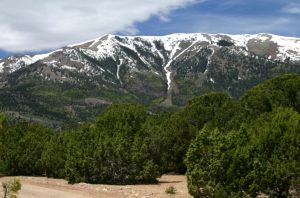
Laccoliths are cicatrice-like, concordant intrusions of magma that form between sedimentary layers. The Henry Mountains of Utah are a famous topographic landform formed past this process. Laccoliths bulge up; a similar downward-bulging intrusion is called a lopolith.
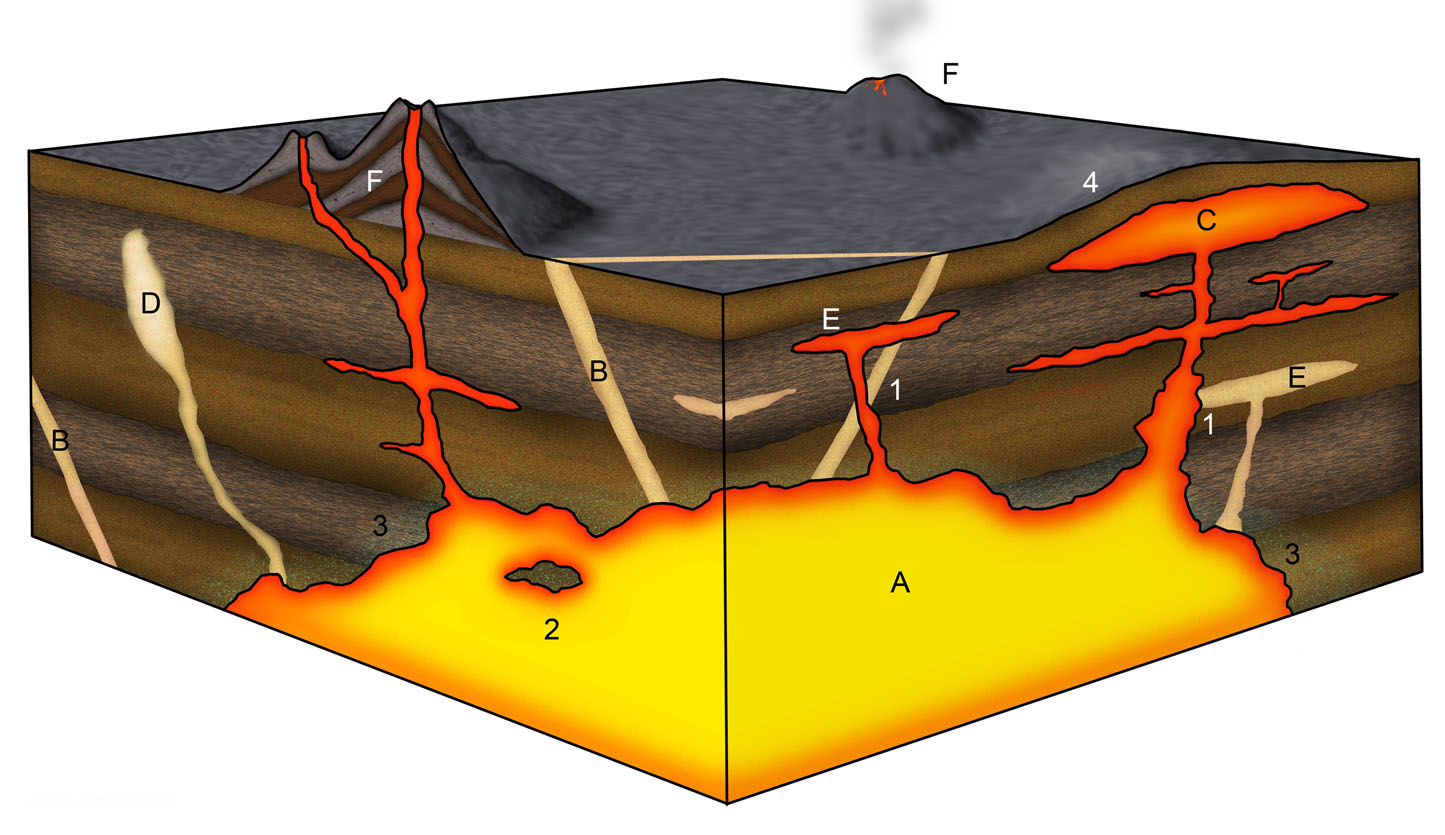
| Guide for Igneous Structures Image (shown above) |
|---|
| Number/Letter of the alphabet | Description |
|---|---|
| 1 | Young, emerging subvolcanic intrusion cutting through older one |
| 2 | Xenolith (solid rock of high melting temperature which has been transported within the magma from deep below) or roof pendant (fragment of the roof of the magma bedroom that has detached from the roof and sunk into the melt) |
| 3 | Contact metamorphism in the country stone side by side to the magma sleeping room (caused by the heat of the magma) |
| 4 | Uplift at the surface due to laccolith emplacement in the most sub-basis |
| A | Active magma chamber (chosen pluton when cooled and entirely crystallized; a batholith is a large rock torso composed of several plutonic intrusions) |
| B | Old magmatic dykes/dikes |
| C | Emerging laccolith |
| D | Onetime pegmatite (late-magmatic dyke formed by aggressive and highly mobile residual melts of a magma chamber) |
| Due east | Old and emerging magmatic sills |
| F | Stratovolcano |
References
1. Peacock, M. A. Classification of Igneous Stone Series. The Journal of Geology 39 , 54–67 (1931).
2. Arndt, North. T. Chapter 1 Archean Komatiites. in Developments in Precambrian Geology (ed. Yard.C. Condie) xi , 11–44 (Elsevier, 1994).
3. Glazner, A. F., Bartley, J. Thou., Coleman, D. South., Gray, W. & Taylor, R. Z. Are plutons assembled over
Source: https://geo.libretexts.org/Bookshelves/Geology/Book%3A_An_Introduction_to_Geology_(Johnson_Affolter_Inkenbrandt_and_Mosher)/04%3A_Igneous_Processes_and_Volcanoes/4.01%3A_Classification_of_Igneous_Rocks
Posted by: stoutonsing.blogspot.com



0 Response to "what large, overall igneous feature makes up the sierra nevada mountains in california?"
Post a Comment